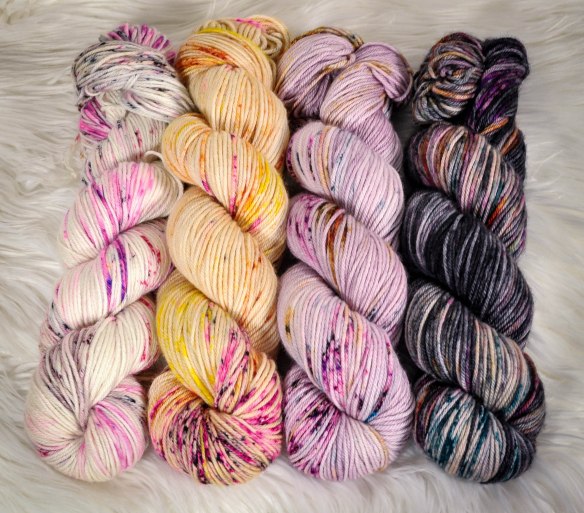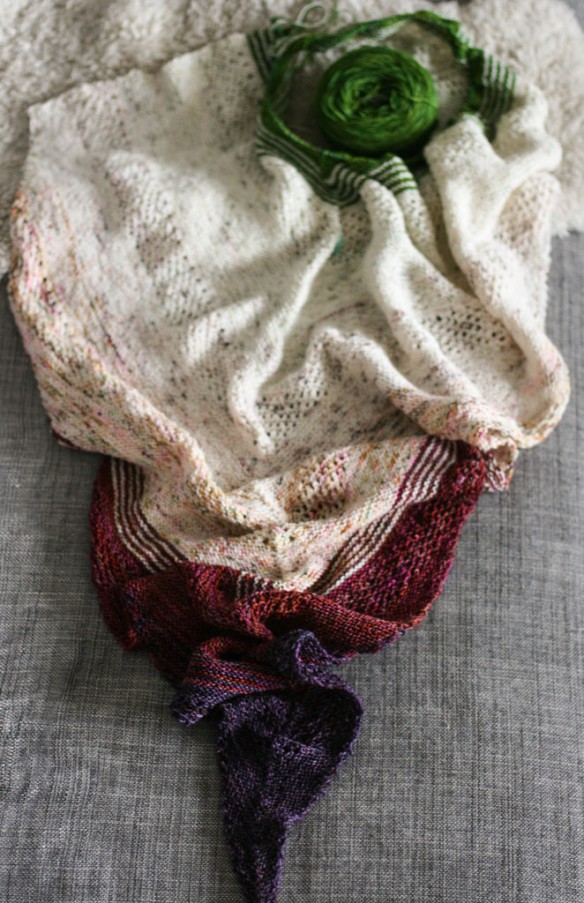
Find Your Fade, by Andrea Mowry. Knit by Tracey Cox in Hedgehog Fibres Sock in (l-r) Vengeance, Swam, Pine, Urchin, Bramble, Pleasant, and Raven.
 The rest of the Eat.Sleep.Knit. Kitties and I are busy finding our perfect fades for the second quarter Andrea Mowry Fade-(US)A-Long! I hope you’ll join us.
The rest of the Eat.Sleep.Knit. Kitties and I are busy finding our perfect fades for the second quarter Andrea Mowry Fade-(US)A-Long! I hope you’ll join us.
Learn more about eligible patterns, yardage requirements, deadlines, and other knitalong info on our website.
We put together lots of fades in the shop for customers, both in person and via email. Hundreds, if not thousands, at this point! It’s one of my favorite things to do. I wanted to give you a bit of insight into my methods for putting together a fade that you’ll love!
I don’t have a background in the visual arts–my experience is with yarn! I majored in English in college and writing fiction is my first love. I didn’t really have much self awareness or interest in color until I met my husband, who’s an abstract painter, and started knitting in the same year: 2002. Color suddenly had a practical application for me now and I ran with it! I hope this info can make building fades and other yarn-y color needs a little easier.
What is a fade?
A knitted fade project uses at least two colorways of yarn that melt and blend into one another when knit in a sequence of skinny stripes. It creates a slow, magical color change. Speckled or variegated colorways melt the best, and its common to sometimes ground a project with semisolids at one or both ends.
So, how can I fade?
Below are some hot tips to help you find the fade of your dreams:
- Fade with your your favorite colorway. What’s your favorite colorway? Start building a fade with it. I love Hawk from Hedgehog Fibres. This Comfort Fade set in Merino DK pulls colors from Hawk–Graphite, orange, pinky lavender–
- Pick skeins with a common color. Look for yarns, with, say, a common dark purple in speckles and covering a larger surface area, and you’ll be surprised what you can blend together. This is typically my starting point for fades when a customer says, “what can I fade with this skein?” What’s a common vein that can run through this project.
- How melty would you like that? Speckled colorways, as well as traditional variegated colors or kettle dyes, melt into one another more than semisolids or solids, which can stripe. This isn’t bad or good, you just need to know what your preference is when choosing your colors. My first Find your Fade has stripy parts and melty parts, and I love it. But you should take it into account when planning out your fade. If you have semisolids you absolutely want to include but also love color melting, you can bookend your fade with them, just like Andrea Mowry’s original Find Your Fade colorway set–which fades from Poison, a dark and moody purple/pink, through a number of speckled and variegated colorways and into the golden yellow colorway Pollen.
- Learn a bit about color theory. Understanding hue, contrast, saturation, and value give you a language for talking about color. This can make communicating your likes and dislikes easier! This blog post from TinCanKnits is a helpful primer. Learning about the color wheel and primary, secondary and tertiary colors can be helpful too, especially if you’re stuck in a rut with your color choices. It’s not for everyone–I enjoy picking out colors more instinctively but do turn to the color wheel for advice when I’m stumped. This basic post on Bluprint is an easy place to start!
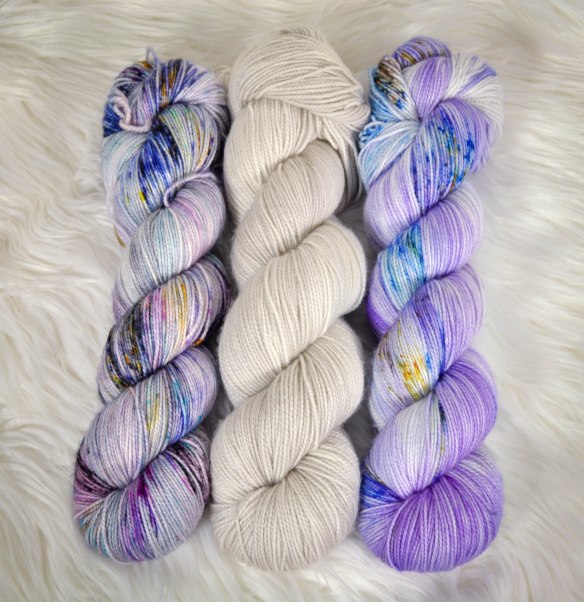
Spun Right Round’s bright lavender is so cheerful to me! This’d be a pretty three color fade melting into a neutral semisolid in the middle! Spun Right Round 80/20 Sock in (l-r) Euphoria, Pigeon, Half a World Away.
- Pick a mood. Fades can be subtle, dramatic, or somewhere in between. If you want something cheerful, go for saturated midtones that fade to lighter tones. If you’d like something dark and broody (always my favorite) go for saturated, dark colors.

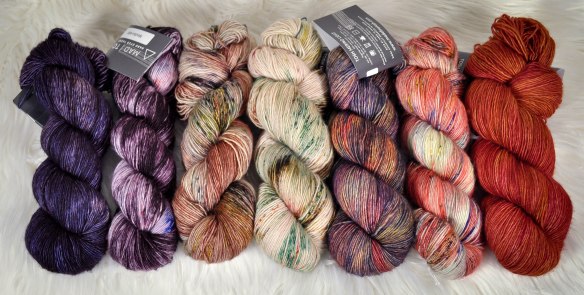
This photo, a sunset over Big Lake in Princeton, Maine, taken by my husband, has always meant home to me! Madelinetosh Merino Light in (l-r) Eleven Dark, Mindful, Dark Roast, Warm Woolen Mittens, Firewood, Bicoastal, The Fox.
- Work from a photo. Starting with a photo you’re attracted to is a much easier starting point than a blank canvas. lI ove The Fox, ESKs exclusive Madelinetosh colorway, to distraction and have already knit Socks and a big sweater out of it but I can’t get enough! I built my Sunset fade (above) around this perfect burnt orange, finding colorways that included my favorite orange and faded to the dark purple in the photo.
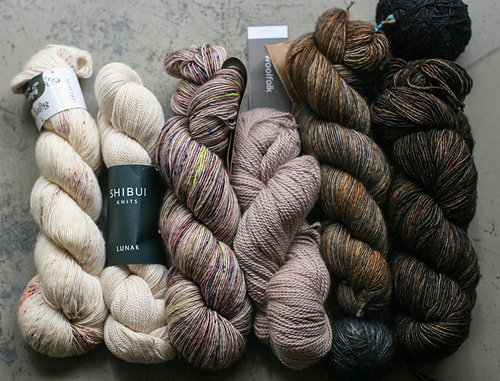
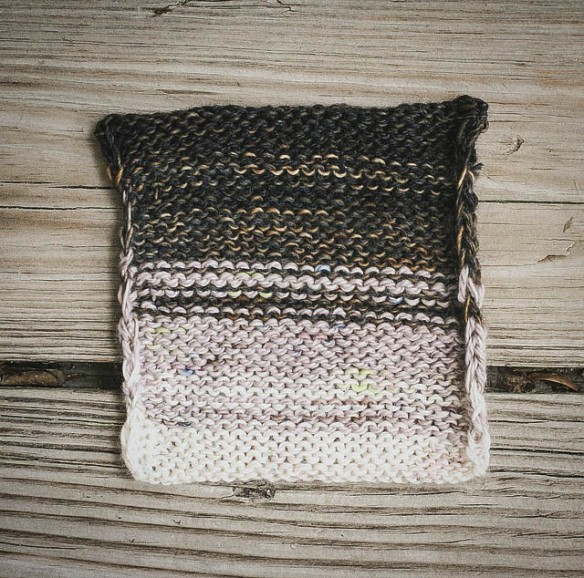
My Comfort Fade Cardigan Swatch!
- Don’t be afraid to mix bases! I know, it’s not for everyone.. If you’re concerned about texture, swatch! The swatch shown above includes 6 different yarn bases (held double with marling in addition to fading) for my Comfort Fade that I’m plotting for the Q2 KAL, and I love it! To start, I stick with the same type of yarn construction when possible unless I’m looking for texture as a design element, like in my Comfort Fade. Base mixing gives you so many more color options for building fades, too. Start out with the basics. If you love beady 2 ply sock yarns, mix Spun Right Round 80/20 Sock, Lola Bean Bean Sprout, Madelinetosh Sock, and Claudia Addiction. Now you have the power of nearly 400 colors available to you!
- Ask for help! We’re so happy to help you with your fade in the shop. You’ll get the input of multiple voices as fades are pulled together in the retail shop. Just email us at eatsleepknit@eatsleepknit.com with your ideas and we’ll help you find your perfect fade!
 Loch Raven Sweater by Emily Connell has smart shaping which makes this a sweater we would grab over & over again. A sweater that fits is such a treasure. Emily Connell uses “short row shaping combined with strategically-placed increases” to make this eye-catching sweater fit just right.
Loch Raven Sweater by Emily Connell has smart shaping which makes this a sweater we would grab over & over again. A sweater that fits is such a treasure. Emily Connell uses “short row shaping combined with strategically-placed increases” to make this eye-catching sweater fit just right. Speaking of shaping, the designer of Clipper just so happens to be the queen of CustomFit, Amy Herzog! She blended fascinating design elements with a simple bottom-up construction to create a cardigan that’s sure to impress at your next knit night or event. Just check out those asymmetrical sleeves and amazing pop of color on the button band. If you’ve yet to venture into the genius idea of CustomFit garments, this is your chance!
Speaking of shaping, the designer of Clipper just so happens to be the queen of CustomFit, Amy Herzog! She blended fascinating design elements with a simple bottom-up construction to create a cardigan that’s sure to impress at your next knit night or event. Just check out those asymmetrical sleeves and amazing pop of color on the button band. If you’ve yet to venture into the genius idea of CustomFit garments, this is your chance! Estri Cardigan by Meiju K-P lets you choose and modify to your heart’s delight. Don’t believe us? Check out the finished projects to see some inventive ways to make this sweater your own. Some omitted the stripes on the sleeves, others used a single color, and some even left off the sleeves to make a super cute vest! The possibilities with this cardigan are endless so let the project planning begin.
Estri Cardigan by Meiju K-P lets you choose and modify to your heart’s delight. Don’t believe us? Check out the finished projects to see some inventive ways to make this sweater your own. Some omitted the stripes on the sleeves, others used a single color, and some even left off the sleeves to make a super cute vest! The possibilities with this cardigan are endless so let the project planning begin.

 The rest of the Eat.Sleep.Knit. Kitties and I are busy finding our perfect fades for the second quarter Andrea Mowry
The rest of the Eat.Sleep.Knit. Kitties and I are busy finding our perfect fades for the second quarter Andrea Mowry 